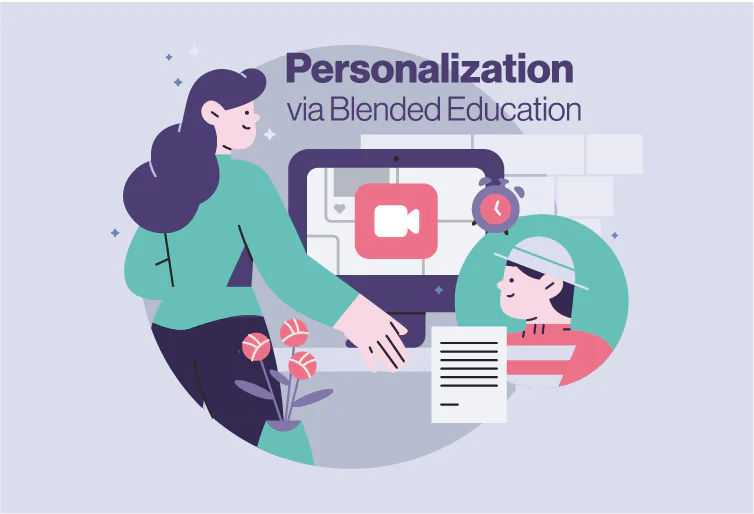As an example of a successful custom blended learning project that we delivered to our clients, the Nation-Wide Online School for Ukraine offers distance and mixed education to over 500,000 students in grades 5-11 across 18 subjects. Developed with the Ministry of Education using customized Open edX technology, it provides a scalable, user-friendly, and inclusive platform.
Importance Of Blended Learning in Education
Blended learning, also known as hybrid learning, is an educational approach that combines traditional face-to-face classroom methods with online instructional media. This model leverages the advantages of both in-person teaching and digital technology to render a more flexible and effective learning experience for students.
Does the integration of self-paced learning with face-to-face interaction offer any benefit to the participants? Are the efforts worth the rewards?
The importance of blended learning lies in its ability to adapt to the diverse needs of learners and the evolving landscape of education. Here are its main features:
Bridging Traditional and Digital Learning
Blended learning brings together the best of both traditional and online education. The online course software integration helps create a more dynamic and adaptable learning environment, allowing students to benefit from direct interaction with teachers while also accessing online resources at their own pace.
Catering to Diverse Learning Styles:
This approach accommodates different types of learners—visual, auditory, and kinesthetic—by providing varied teaching methods and materials. Students can engage with content through videos, readings, interactive activities, and hands-on projects, enhancing their overall educational experience.
Supporting Lifelong Learning:
Blended learning promotes continuous learning by enabling students to revisit materials and learn at their own pace. This is essential for professional and personal growth in a rapidly evolving world, fostering self-directed learning and adaptability.
Enhancing Technological Skills:
In today’s digital-centric world, familiarity with technology is crucial. Blended learning not only imparts subject knowledge but also helps students develop important technological skills, preparing them for future academic and professional endeavors while maintaining critical face-to-face interpersonal skills.
However, like with any other educational paradigm, there exist advantages and disadvantages of blended learning strategies. On one hand, it offers flexibility, personalized learning paths, and access to a wealth of online resources. On the other hand, it may present challenges such as the need for reliable internet access, potential technological barriers, and the requirement for students to be self-motivated and disciplined.
The benefits of blended learning make it a valuable model in modern education. By combining the strengths of traditional teaching and digital technologies, it enables educators to develop a more engaging and advanced curriculum. This creates an enriched educational experience that prepares students for the demands of the 21st-century world.
Advantages of Blended Learning
Blended learning is changing how we approach education, with 73% of teachers seeing increased engagement and 82% of students preferring it over traditional methods—a clear win-win. By combining traditional face-to-face lessons and in-person classes with online educational resources, this approach not only boosts motivation and academic ability but also shows that happier students mean better financial outcomes for learning providers, proving you can have your cake and eat it too.
This concept involves creating dynamic and flexible online learning platforms for virtual training environments. In this section, we will explore the benefits of blended learning and its importance for teachers, students, and corporate training programs.
Advantages for Teachers
Blended learning offers numerous advantages for educators, enhancing their teaching methods and improving student engagement.
Flexible Teaching Methods
Blended learning allows teachers to utilize a variety of instructional methods, combining lectures, interactive activities, and online resources. This flexibility enables educators to cater to different learning styles and keep students engaged, including asynchronous learning methods.
Efficient Use of Resources
By integrating digital materials and conducting online classes, teachers can save time on lesson preparation and focus on delivering quality instruction. Online resources can be easily updated and shared, reducing the need for physical materials.
Personalized Instruction
With access to online platforms, teachers can provide personalized feedback and support to individual students via online calls or instant messaging. This approach helps address specific learning needs and promotes a deeper understanding of the subject matter.
Enhanced Student Engagement
The combination of multimedia content and interactive activities increases student interest and participation. Teachers can incorporate videos, quizzes, and discussions to make lessons more engaging, fostering better interaction between students and instructors.
Access to Real-Time Data and Feedback
Online tools provide teachers with real-time data on student performance, allowing them to adjust their teaching strategies for e-learning conditions promptly. This immediate feedback helps identify areas where students may need additional support.
Advantages for Students
Blended learning significantly benefits students by providing a more tailored and accessible educational experience.
Round-the-Clock Access to Learning Resources
Since blended learning involves online and digital resources, students have 24/7 access to educational materials, provided they have a good internet connection. This constant availability allows them to study at their own pace and revisit challenging topics as needed.
Personalized Learning Experience
Blended learning offers a personalized training experience, catering to individual learning needs. Students can choose their own learning paths through specific topic areas, focusing on the information and skills they find most relevant without sitting through lengthy lectures on subjects they already understand.
Accommodation of Different Learning Styles
It’s universally acknowledged that individuals have varied learning mechanisms.
Blended learning caters to:
- Visual Learners: Through videos and visual aids.
- Auditory Learners: Via podcasts and audio recordings.
- Read/Write Learners: With extensive written materials and readings.
- Kinesthetic Learners: Through interactive simulations and hands-on projects.
- Logical Learners: By incorporating problem-solving activities.
- Social Learners: Through group projects and online forums.
- Solitary Learners: By allowing self-paced study sessions.
Flexibility in Learning Pace and Schedule
Students can manage their own learning schedules, balancing education with other responsibilities. This flexibility is particularly beneficial for those with part-time jobs or family commitments.
Increased Engagement Through Interactive Content
The use of multimedia and interactive online platforms makes learning more engaging. Students can participate in forums, collaborate on projects, and access interactive simulations, enhancing their overall educational experience and engagement.
Advantages for Corporate Training
Blended learning also plays a crucial role in professional development, offering significant benefits of blended learning in corporate training environments.
Cost-Effective Training Solutions
Blended learning reduces costs associated with traditional training methods, such as travel expenses, printed materials, and facility rentals. Online components allow for broader reach without significant additional expenses.
Scalable Training Programs
Companies can easily scale their training programs to accommodate a growing number of employees across various locations. Online modules can be accessed by many users simultaneously without logistical constraints.
Consistent Training Across Locations
Blended learning ensures all employees receive the same quality of training, regardless of their location. Standardized online content maintains consistency in messaging and learning outcomes.
Flexibility for Employees
Employees can access training materials at times that suit their schedules, reducing disruptions to their work responsibilities. This flexibility enhances participation rates and allows for better integration of learning into daily routines.
Immediate Application of Skills
Blended learning enables employees to acquire and apply new skills and knowledge immediately in their work environment. Interactive online modules and real-world assignments facilitate the practical application of concepts learned.
Development of a More Engaging and Advanced Curriculum
By merging traditional teaching with digital technologies, corporate trainers can develop a more successful curriculum. This approach keeps training content up-to-date and relevant, ensuring employees acquire the skills needed to meet modern business challenges.
Importance of Blended Learning in Corporate Training
The importance of blended learning in corporate training cannot be overstated. It enhances employee performance by providing continuous learning opportunities and fosters a culture of professional development. Thanks to the benefits of blended learning, organizations can improve employee satisfaction, retention, and overall company productivity.
To explore how continuous education and blended learning can drive your institution’s growth, visit our product page: Continuous Education Solution for Universities.
The Disadvantages of Blended Learning
Here is a list of challenges and cons of blended learning to consider when incorporating it into your training program.
High Maintenance Cost
Incorporating advanced technology into your blended learning projects, such as infrastructure setup and devices, can be costly at times. In a corporate setting, this is especially true for larger organizations with various departments or a large workforce.
However, if you compare this cost with all the other benefits that come with blended learning, it is not only a short-term expense but will eventually be quite beneficial in the long run.
Technological Dependence
To achieve the learning objectives of your blended learning program, content developers use technological tools and resources that are easy to use, reliable, and up-to-date. All of this is possible if participants have strong internet connectivity, as this has a significant impact on the overall learning environment and experience.
That is why incorporating this learning strategy depends on technological feasibility, and in cases of technical issues or inadequate technical accessibility, the objectives of this advanced learning strategy become unachievable.
Also, since blended learning relies heavily on technology, there is a limitation regarding the technical skills of both instructors and learners. Students and instructors who are not tech-savvy can face significant barriers in terms of smooth interactions. Participants may face difficulty in accessing the course material; therefore, this learning strategy must come with adequate technical support.
Wastage of Offered Resources
This point is connected to the limitation discussed above. If learners or students are unfamiliar with the technology used in the online learning course, there is a chance you won’t get the desired results. Similarly, if the provided technological tools are inadequate or not relevant to the course material, then this will result in a wastage of resources without improving ROI in education.
Blended Learning vs. Hybrid Learning: Is There a Difference?
With the widespread adoption of digital tools and online platforms in education, especially in response to global shifts towards remote learning, terms like blended learning and hybrid education have become central to modern teaching strategies. These terms are often used interchangeably, but understanding the subtle differences between these approaches—including the hybrid learning advantages and the hybrid learning pros and cons—is essential for educators and learners aiming to maximize their educational experience.
| Feature | Blended Learning | Hybrid Learning |
| Definition | An educational model that combines traditional face-to-face instruction with online learning activities. | A teaching approach where some students attend class in person while others participate online simultaneously (hybrid education). |
| Focus | Integration of online and offline elements to enhance learning, allowing for self-paced and personalized learning paths. | Delivering the same lesson to both in-person and remote students at the same time, emphasizing flexibility and real-time interaction. |
| Examples | – Students attend classes and complete online assignments.
– Online resources supplement classroom teaching. |
– Live-streamed lectures where remote students join in real-time.
– Classrooms with both physical and virtual participants engaging simultaneously. |
| Advantages | – Offers flexibility in learning schedules.
– Supports different learning styles. – Enhances student engagement through varied instructional methods. – Facilitates personalized learning experiences. |
– Provides continuity during disruptions.
– Accommodates students who cannot attend in person. – Maintains synchronous interaction among all students. – Combines the benefits of in-person and hybrid learning advantages. |
| Disadvantages | – Requires self-discipline and motivation.
– Potential technical issues. – May need significant planning and resources. |
– Requires robust technological infrastructure.
– Challenges in engaging both in-person and remote students equally. – Teachers must manage dual audiences simultaneously. – Involves considerations of technology dependence and classroom dynamics (see more in the hybrid learning pros and cons). |
| Relationship | A broad term encompassing various methods of integrating online and face-to-face instruction, including hybrid learning. | A specific type of blended learning focusing on synchronous delivery to both in-person and remote students. |
Case Study: Blended Learning in Action – Nation-Wide Online School for Ukraine
The Nation-Wide Online School for Ukraine is a compelling example of how the benefits of blended learning in education can revolutionize a nation’s educational system. By seamlessly integrating traditional classroom instruction with advanced digital technologies, the platform delivers education to over 500,000 students in grades 5-11 across 18 subjects. This innovative approach has modernized the educational landscape, providing a flexible, engaging, and inclusive learning environment that caters to diverse student needs and overcomes geographical barriers.
Key Features and Pivot Points:
- Integration of Traditional and Digital Learning: Combines face-to-face meetings with online resources to offer a comprehensive educational experience, exemplifying the benefits of blended learning in education.
- Personalized Learning Paths: Allows educators to customize courses and learning materials, catering to individual student needs and learning styles.
- Robust Technological Infrastructure: Utilizes customized Open edX® technology features to support high user loads and ensure seamless platform performance.
- Interactive and Engaging Content: Incorporates multimedia resources, interactive quizzes, and assignments to enhance student engagement and participation.
- Teacher Empowerment Tools: Features a customizable Teacher’s Office for course management, progress monitoring, and collaboration among educators.
- Inclusivity and Accessibility: Includes features like sign language translation and audio descriptions to support students with diverse needs and promote equal access to education.
Similar solutions can be developed using these technologies for any private or public school. If you’re interested in implementing a blended learning platform tailored to your educational needs and leveraging the benefits of blended learning in education, please contact us for consulting.
The Bottom Line
Like any learning strategy, there are both advantages and disadvantages of blended learning. In today’s world, the learning and working environments offer unparalleled opportunities for training by adopting the blended learning approach. This method combines the best of traditional education with digital media, creating a more efficient, engaging, and facilitated learning experience than ever before.
To achieve your learning objectives optimally, content developers must wisely integrate technological and relevant aspects into the learning materials. Blended learning fosters greater engagement among learners, improves retention rates in organizations, keeps learners motivated, and provides an ideal environment for both personal and professional development programs.
While it retains the core values of traditional learning, blended learning leverages technological advancements to save both time and money, making it a highly feasible option. This strategy has paved the way for numerous learning platforms globally and has become one of the most widely adopted educational tools today, demonstrating both its strengths and areas for careful consideration.
Make sure to book a call with our experienced consultants.




